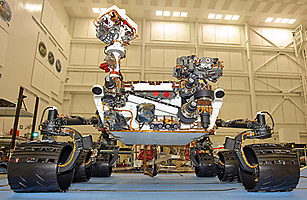
Like pretty much every other agency in the government, NASA is likely to be hurting for money over the next few years. The end of the Space Shuttle program, which comes with Atlantis’ final flight next month, will free up some cash. But at best, NASA’s budget will be flat in 2012, and given the mood in Congress, “at best” isn’t something to count on. And thanks to the cost overruns plaguing the yet-to-be-launched James Webb Space Telescope, the agency’s science programs are especially vulnerable to cuts.
But that’s down the road. For now, things are positively hopping at the Kennedy Space Center. Last week, a brand-new Mars rover, named Curiosity, arrived at Cape Canaveral to be prepared for launch this coming November. But long before that — as early as August 5, if conditions are right — a new probe called Juno will be on its way to Jupiter, followed by the GRAIL mission in September, designed to study the Moon’s gravity field in unprecedented detail.
It’s unlikely that GRAIL will ever be called “plucky,” and while a better understanding of the Moon is always a good thing, it won’t add to our knowledge the way Juno’s exploration of Jupiter and Curiousity’s perambulations over the Martian terrain will. Still, it’s good news that NASA continues to explore the Solar System in such a wide variety of ways . Money may get tighter from here on out, but if these missions are as successful as their designers expect, the agency might feel some pressure to keep coming up with new ones — and get the funding it needs to deliver.
See “The Hubble Space Telescope’s Greatest Hits.”
See TIME’s complete space and astronomy coverage.